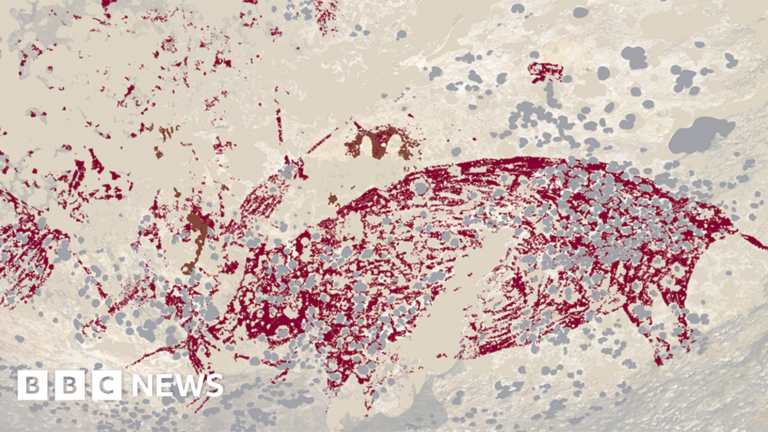Image source, BRIN Google Arts & Culture
The oldest example of figurative rock art has been discovered on the Indonesian island of Sulawesi by Australian and Indonesian scientists.
The painting depicting a wild pig and three human figures is at least 51,200 years old, more than 5,000 years older than the previous oldest rock art.
This discovery pushes back the time to which modern humans first demonstrated the capacity for creative thought.
Professor Maxime Aubert of Griffith University in Australia told BBC News the discovery would change ideas about human evolution.
“This painting tells a complex story. It is the earliest evidence we have of narratives. It shows that humans at that time had the ability to think in abstract terms,” he said.
Image source, BRINN Google Arts and Culture
The painting shows a motionless pig with its mouth partly open and at least three human-like figures.
The largest human figure has both arms outstretched and appears to be holding a rod. The second is directly in front of the pig, with its head next to its snout. It also appears to be holding a stick, one end of which may be in contact with the pig’s throat. The last human-looking figure appears to be upside down, with its legs turned upwards and spread outwards. It has one hand reaching towards the pig’s head and appearing to touch it.
The team of scientists was led by Adhi Agus Oktaviana, an Indonesian rock art expert from the National Research and Innovation Agency (BRIN) in Jakarta. Storytelling, he said, played a crucial role in early human culture in Indonesia from the earliest times.
“Humans have probably been telling stories for much longer than 51,200 years, but because words do not fossilize, we can only rely on indirect approximations such as depictions of scenes in art – and the art from Sulawesi is now by far the oldest evidence of this type known to archaeology,” he said.
Image source, JOHN READER/SPL
The earliest traces of drawings were found on rocks in the Blombos Caves in South Africa and date back 75,000 to 100,000 years. These drawings consist of geometric patterns.
The new painting, in the Leang Karampuang limestone cave in the Maros-Pangkep region of South Sulawesi, shows figurative art – an abstract depiction of the world around the person or people who painted it.
So it is an evolution of the thought processes of our species that gave birth to art and science.
“It seems that something happened about 50,000 years ago, shortly after which all other human species, such as Neanderthals and the so-called Hobbit, became extinct.
“It’s very romantic to think that at some point in this era something happened in the human brain, but I think it’s more likely that there are even older examples of figurative art.”
Image source, Rémi Masson/SPL
Professor Chris Stringer of the Natural History Museum in London believes there may be examples of ancient figurative art in Africa, where modern humans first evolved, but we have yet to find any.
“This discovery reinforces the idea that figurative art was first produced in Africa, more than 50,000 years ago, and the concept spread as our species spread.
“If this is true, much further evidence from other regions, particularly Africa, remains to be provided. Clearly, this earliest dating is the result of work on a single panel at a single site. Hopefully, further dating will be carried out at other sites to confirm this apparently crucial discovery.”
The new dating was made possible by a new method that involves cutting out tiny parts of the work using a laser. This allows researchers to study different parts of the work in more detail and achieve a more precise dating.
As the new method becomes more widely used, more rock art sites around the world may be re-dated, potentially further delaying the emergence of figurative art.
Image source, PHILIPPE PSAILA/SPL
Until a decade ago, the only evidence of ancient cave art was in Spain and southern France, leading some to believe that the creative explosion that gave rise to the art and science we know today began in Europe.
Then, in November 2018, in the Lubang Jeriji Saléh cave on the Indonesian island of Borneo, scientists discovered the oldest artwork representative of the period, more than 40,000 years old, depicting an unknown animal.
Griffith University Professor Adam Brumm said the latest Indonesian rock art discoveries shed new light on the important role of storytelling in art history.
“It is remarkable that the oldest rock art we have discovered in Sulawesi so far consists of recognizable scenes: that is, paintings that depict humans and animals interacting in such a way that we can infer that the artist intended to communicate a narrative of some kind – a story,” he said.


